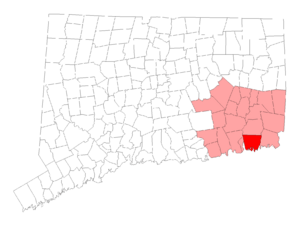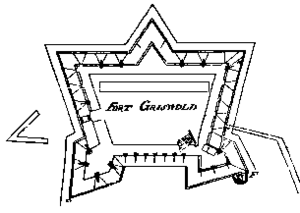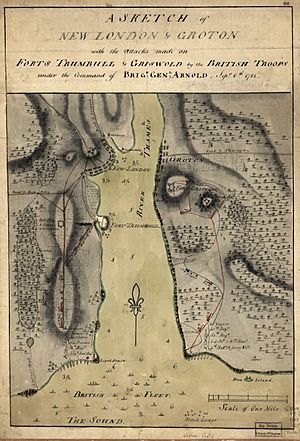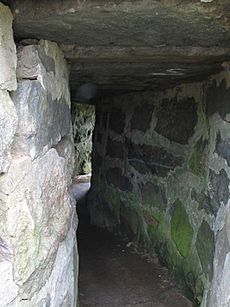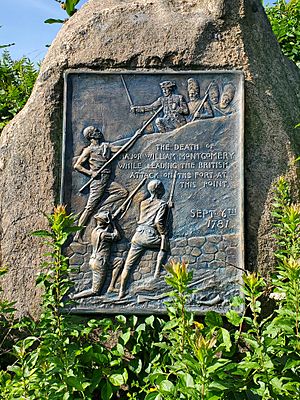Battle of Groton Heights facts for kids
Quick facts for kids Battle of Groton Heights |
|||||||
|---|---|---|---|---|---|---|---|
| Part of the American Revolutionary War | |||||||
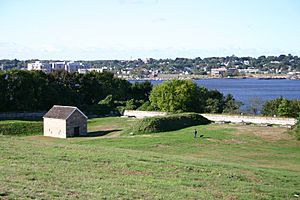 Fort Griswold on Groton Heights, across the Thames River from New London. |
|||||||
|
|||||||
| Belligerents | |||||||
| Commanders and leaders | |||||||
| William Ledyard † William Latham |
Benedict Arnold Edmund Eyre John Bazely |
||||||
| Strength | |||||||
| New London: Unknown Fort Griswold: 150 regulars |
1,700 regulars (800 engaged at Fort Griswold) | ||||||
| Casualties and losses | |||||||
| 85 killed 60 wounded (many mortally) |
52 killed 145 wounded |
||||||
The Battle of Groton Heights was an important fight during the American Revolutionary War. It happened on September 6, 1781, in Connecticut. A small group of American militia, led by Lieutenant Colonel William Ledyard, defended against a larger British force. The British were led by Brigadier General Benedict Arnold, who had switched sides from the Americans.
The British wanted to attack the port of New London, Connecticut. Their goal was to make General George Washington stop his march towards Lord Cornwallis's army in Virginia. The British successfully raided New London. However, the American militia bravely fought back at Fort Griswold in Groton, Connecticut. This fort was across the Thames River from New London.
New London was burned, and some ships were destroyed. But many other ships managed to escape up the river. The British eventually took Fort Griswold. Sadly, many American defenders were killed even after they tried to surrender. This event is sometimes called the "Fort Griswold massacre." The high number of British soldiers killed or hurt led to criticism of Benedict Arnold. This battle was one of the last major fights in the northern United States during the war. It happened just before the big Siege of Yorktown, which ended the war.
Contents
Why the Battle Happened
Groton, Connecticut, has a long history, going back to 1655. It was once part of New London, which was a bigger town across the Thames River. This area was a very important port for ships. It became one of the largest ports along the New England coast. Groton became its own town in 1705.
During the American Revolutionary War, the Groton-New London port was a key place for American ships. Many American privateer ships operated from here. These ships attacked British trading vessels. However, the port was not very well protected. Fort Trumbull was on the New London side. It was a small fort, open on one side. Fort Griswold in Groton was a stronger fort. It was square-shaped with strong walls and a ditch around it.
Both forts usually had small groups of militia soldiers. Lieutenant Colonel William Ledyard was in charge of defending the area. The forts often lacked enough supplies, like gunpowder and cannonballs. Fort Trumbull was not even finished. Fort Griswold was built, but it didn't have enough supplies or soldiers to fight a big attack.
In August 1781, American General George Washington saw a chance to attack the British army in Virginia. This army was led by Lieutenant General Charles Cornwallis. Washington started moving his troops south from New York. He used tricks to fool Lieutenant General Sir Henry Clinton. Clinton was the main British commander in New York City.
Clinton realized on September 2 that Washington had tricked him. He couldn't move his troops fast enough to help Cornwallis. He also didn't want to send too many soldiers away from New York. So, Clinton decided to attack Connecticut. He hoped this raid would make Washington turn back. Clinton also thought New London could be a good base for future British operations. He put Brigadier General Benedict Arnold in charge of this attack. Arnold was from Norwich, Connecticut, near New London. He had been a successful American general but had joined the British side a year earlier.
Getting Ready for Battle
The British gathered about 1,700 soldiers for the attack. They split into two groups. The first group was led by Lieutenant Colonel Edmund Eyre. It included soldiers from the 40th and 54th Regiments of Foot. It also had a Loyalist group called the New Jersey Volunteers. Loyalists were Americans who supported the British.
The second group was led by Benedict Arnold. It included the 38th Foot and other Loyalist groups. These included the Loyal American Regiment and Arnold's own American Legion. The British also had about 100 Hessian soldiers. Hessians were German soldiers hired by the British. They also had some artillery, like cannons.
The soldiers got on ships on September 4. They sailed with smaller armed ships. Commodore John Bazely led the fleet. They planned to land at New London at night on September 5. But strong winds kept their ships from reaching the port until daylight on September 6.
Rufus Avery, an American officer at Fort Griswold, saw the British ships arrive. He said, "about three o'clock in the morning, as soon as I had daylight so as to see the fleet, it appeared a short distance below the lighthouse." He quickly told Captain William Latham, who commanded Fort Griswold. Latham then sent a message to Colonel William Ledyard, who was in charge of all defenses.
When Ledyard got the message, he sent someone to tell Governor Jonathan Trumbull. He also warned local militia leaders. Ledyard then went to Fort Griswold to prepare its defenses. The fort's cannons fired twice. This was a signal that the enemy was coming. But one British ship fired a third shot. This changed the signal to mean a friendly ship was arriving. This confusion caused delays in getting more American militia to help.
At sunrise on September 6, the British landed on both sides of the Thames River. The people in New London had to leave their homes. Several ships in the harbor escaped upriver. Benedict Arnold's 800 soldiers landed in New London. They didn't face much resistance.
The 23 American defenders at Fort Trumbull fired once. Then they disabled their cannons and crossed the river to Fort Griswold. They were following orders from Colonel Ledyard. Seven of these men were wounded, and one boat was captured. Arnold's troops then went into New London. They started destroying supplies and naval goods. Arnold had ordered that some parts of the town be saved. But one building had a lot of gunpowder inside. Arnold didn't know this. When it exploded, it set fire to nearby buildings. The fire quickly spread, burning 143 buildings.
Meanwhile, Lieutenant Colonel Eyre's 800 soldiers landed on the east side of the Thames River. They moved slowly through thick woods and swamps. The New Jersey Loyalists landed after the first group. They were also delayed by moving cannons through the difficult land. They did not join the main attack on the fort.
Major Montgomery, one of Eyre's officers, sent a messenger to Fort Griswold. He demanded that the fort surrender. Colonel Ledyard sent a message back saying, "Colonel Ledyard will maintain the fort to the last extremity." Eyre sent another message, threatening to kill everyone if they didn't surrender. Ledyard gave the same answer. Some of his officers wanted to leave the fort and fight outside, but Ledyard refused.
Arnold ordered Eyre to attack the fort. He thought it would be easy to capture. But when Arnold saw the fort, he realized it was stronger than he thought. Many American boats had already escaped upriver. So, Arnold tried to call off Eyre's attack. But the battle started just minutes before Arnold's message arrived.
The Battle at Fort Griswold
After the Americans refused to surrender, Eyre launched a full attack on Fort Griswold. About 150 American defenders were inside. Stephen Hempstead, an American sergeant, described the attack. He said the British "marched with great rapidity, in a solid column." They rushed to attack the southwest part of the fort and other sides.
As the British got close, the Americans fired grapeshot at them. Grapeshot is like many small cannonballs. This killed and wounded many British soldiers. They scattered for a moment but then regrouped. Eyre led one group against the southwest part of the fort. American fire pushed them back, and Eyre was badly wounded. Major William Montgomery led the second group. They went to an empty fort section east of the main fort. From there, they crossed the ditch and attacked the walls.
This group managed to get inside the fort after fierce fighting. But Major Montgomery was killed by Jordan Freeman. Freeman was a Black man who had been a slave and was serving Colonel Ledyard. Montgomery's soldiers then opened a gate from inside. British troops poured into the fort. Seeing that the fort was taken, Colonel Ledyard ordered his men to stop firing. He prepared to surrender to the British.
What happened next is still debated. American accounts say that the British kept firing at the Americans. This happened even after Ledyard tried to surrender. Many American soldiers were killed or badly wounded. Rufus Avery wrote that the British "killed and wounded nearly every man in the fort as quick as they could." Jonathan Rathbun said a British officer killed Colonel Ledyard with Ledyard's own sword.
Some stories say Captain George Beckwith killed Ledyard. Others say it was Captain Stephen Bromfield. Bromfield took command after Major Montgomery was killed. A Black soldier named Lambert Latham is said to have killed the British officer who killed Colonel Ledyard. Stephen Hempstead remembered the terrible scene. He said, "Never was a scene of more brutal wanton carnage witnessed than now took place."
British accounts give different reasons for what happened. During the battle, the fort's flag was shot down. Some British soldiers thought this meant the Americans were surrendering. Then, the British suffered many casualties when they approached the fort. They thought the Americans wouldn't shoot. So, they were angry about their losses and didn't trust Ledyard's surrender. Other accounts say some Americans in the fort didn't know Ledyard had surrendered. They kept fighting. So, the British soldiers also kept fighting.
Two Black men and one American Indian were among the defenders of Fort Griswold. Jordan Freeman and Lambert Latham were the Black men. They fought bravely and were killed. Tom Wansuc was a Pequot Indian. He was stabbed with a bayonet.
What Happened After the Battle
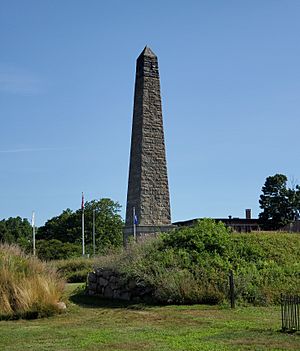
The Battle of Fort Griswold was a huge tragedy for Groton and Connecticut. It was one of the last British victories in North America before the war ended. New London was badly damaged. Many homes were burned, and the town's waterfront was destroyed. Nearly 100 families lost their homes.
Many American soldiers died at Fort Griswold. The Groton Gazette reported about 150 casualties. Some survivors escaped, like George Middleton. Others were taken prisoner, including Stephen Hempstead. He said, "After the massacre, they plundered us of everything we had, and left us literally naked." Hempstead was wounded. He said he was put on a wagon with other wounded men to be taken to the ships. The wagon rolled down a hill and hit a tree. This threw some men off and made their injuries worse. Arnold reported that 85 men were found dead in Fort Griswold. He said 60 were wounded, most of them very badly. Twelve-year-old William Latham was also captured but was released because of his age.
Arnold later reported that 48 British soldiers were killed and 145 were wounded. General Clinton praised Arnold for his "spirited conduct." But Clinton also complained about the high number of British casualties. About 25 percent of the soldiers sent against Fort Griswold were killed or wounded. One British observer said it was like "a Bunker Hill expedition." Many British soldiers blamed Arnold for the events at Fort Griswold. Arnold then suggested attacking Philadelphia. But General Charles Cornwallis surrendered at Yorktown in October. This ended the idea of more raids.
Remembering the Battle
The British tried to burn down Fort Griswold's gunpowder storage. But an American militiaman went into the fort and put out the fire. Fort Trumbull was rebuilt in the 1800s. Both Fort Trumbull and Fort Griswold are now state parks. The Fort Griswold park also has the Groton Monument. This monument was built in the 1820s to remember the battle. Both forts are listed on the National Register of Historic Places.
There is a plaque at the main gate of Fort Griswold. It lists the names of the fort's defenders and what happened to them.
Images for kids


